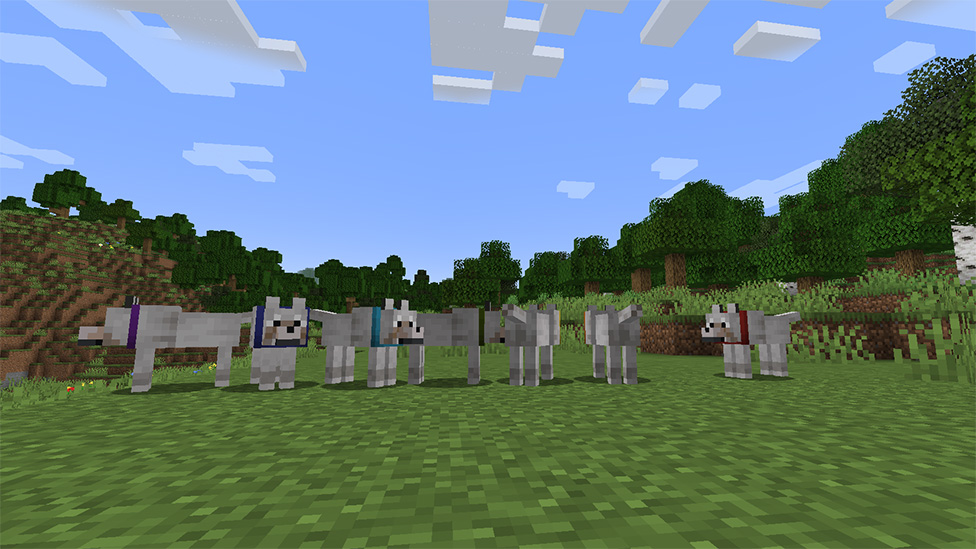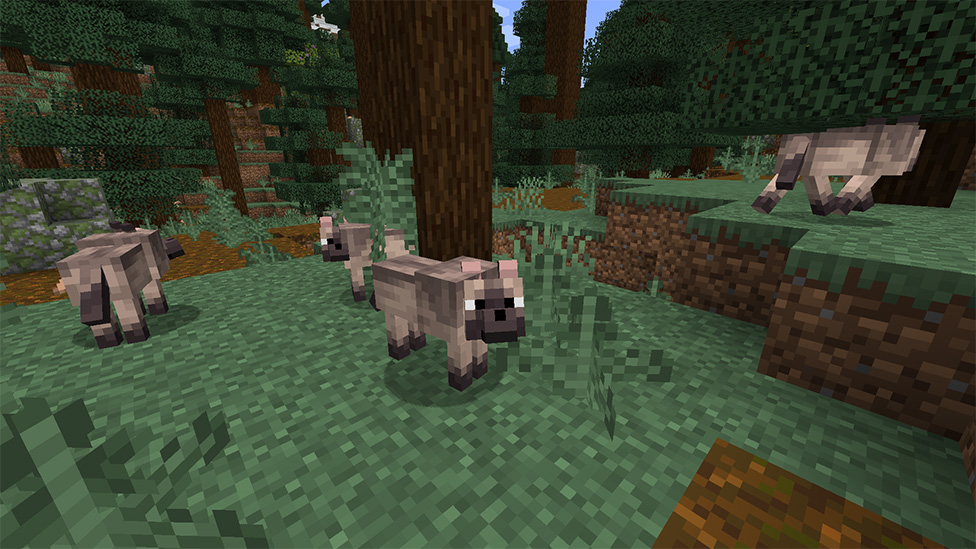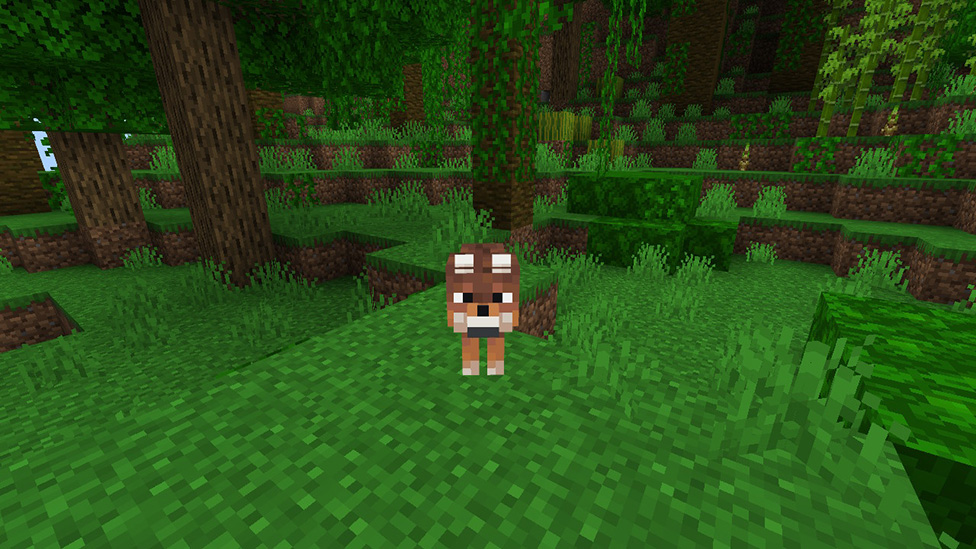Things You Didn't Know About Wolves in Minecraft
Make Your Own Minecraft Server For Free
Your own Minecraft server is only 5 minutes away! We support simple one click install for over 1000 unique modpacks.
Free Minecraft Server Hosting

Their Collars Can Be Dyed
Upon encountering a wild wolf in Minecraft, it's easy to appreciate their untamed beauty. However, the real magic happens once you tame them. Instantly, a red collar materializes around their necks, a charming symbol of their new status as a loyal companion. Did you know you can customize your tamed wolf's collar color? By right-clicking on your wolf while holding any dye, you can change the default red to a color of your choice. This lesser-known feature lets players personalize their wolf companions by adding a splash of color and uniqueness to their in-game experience.Most Common Spawn Points
Wolves, like other mobs in Minecraft, prefer biomes where they are most likely to spawn. To find these majestic creatures, explore taiga and forest biomes, where their distinct bark can guide you from blocks away. However, arid biomes like deserts and ice plains rarely host wolves. So, if you seek a new wolf companion, search the lush forests and taigas they call home.
They Have a Hunter's Instinct
Wolves in Minecraft mirror their real-world counterparts in many ways, particularly in their hunting instincts. Though they may seem docile and harmless when relaxed, their eyes glow fiercely red and their predatory nature emerges when certain passive mobs like rabbits, foxes, skeletons, llamas, sheep, and baby turtles enter their vicinity. This is a crucial aspect to consider, especially if you have sheep farms in forest and taiga biomes. Unattended and unprotected, these farms could fall prey to the natural hunting instincts of these otherwise friendly wolves.They Prefer Bones When Untamed
For those new to the world of Minecraft and curious about how to tame a wolf, the process is intriguing yet straightforward. The key lies in one simple item: bones. While there isn't a fixed number of bones required, as the taming process is somewhat random, persistently clicking on a wolf with a bone in hand usually does the trick. Once you see hearts appear above its head, congratulations, you've just tamed a wolf! Interestingly, once tamed, wolves lose their interest in bones and prefer meat instead. This switch in dietary preference adds a layer of realism to the game, showing a transition from wild to domesticated behavior.Once Tamed, They're Super Loyal
Minecraft wolves showcase a level of loyalty reminiscent of domestic dogs. Once tamed, they respond diligently to their owner's commands. For instance, you can make your wolf sit and stay in one place, and it will obediently remain there, barring any damage. When they are not sitting, they will faithfully follow you across the game's vast landscapes. If you move quickly or traverse bodies of water, don't worry about losing them; they possess the ability to teleport to your location, provided the chunk they're in is loaded. This unwavering loyalty not only adds to the charm of these companions but also brings a sense of security and companionship to your Minecraft adventures.They Eat Anything
Taming a wolf in Minecraft makes keeping them fed surprisingly easy. Unlike some passive mobs, wolves don't need constant feeding to survive. However, occasional treats strengthen your bond with these virtual pets. Intriguingly, wolves aren't picky eaters. They'll gladly eat any meat you provide, even overlooked rotten zombie flesh. This lets you make use of loot that would otherwise go to waste. Furthermore, wolves are uniquely immune to the food poisoning affects that afflict players when consuming raw chicken or rotten flesh, making them less demanding and more resilient companions.They're Easy to Breed
Breeding passive mobs in Minecraft follows a consistent pattern, and wolves are no exception. When you feed meat to two tamed wolves, they enter love mode, signified by the appearance of hearts, and soon after, a puppy is born. This puppy, an adorable mini version of its parents, will grow on its own over time. However, you can speed up its growth by feeding it more meat. Watch for the green stars that appear around the puppy, indicating its accelerated growth. This straightforward breeding process not only adds to the game's fun but also allows players to grow their pack of loyal companions.
They Stand Up For Each Other
In the wild, wolves are known for their pack mentality, displaying loyalty and protection towards each other. This behavior is brilliantly mirrored in Minecraft. In the game, if a player attacks an untamed wolf, the entire pack nearby turns hostile and bands together to defend their pack member. This collective response serves as a natural deterrent, warning players to think twice before provoking these creatures. It's a fascinating feature that adds depth to the game's ecosystem, reinforcing the idea that wolves are not solitary beings but part of a larger, interconnected group.They Can't Watch Their Owner Suffer
In Minecraft, a tamed wolf is more than a pet; it's a steadfast ally, ready to defend you against any threat. Though obedient when told to sit and stay, a wolf will break stance to protect its owner from harm. This unwavering commitment reflects the deep bond between player and wolf. Whether fending off monsters or exploring picturesque lands, a wolf at your side ensures you have a loyal companion who will leap to your defense without hesitation. Their protective nature makes wolves invaluable allies on any Minecraft journey.They Communicate When They're Hungry or Hurt
Like their real-world counterparts, Minecraft wolves have distinctive ways of conveying their needs and emotions. For example, while they don't need constant nourishment, they will signal interest in food by tilting their heads—an adorable habit that imitates actual dogs begging for treats. More importantly, if a wolf is injured, perhaps during a battle or an accidental fall, it begins to whine, signaling its distress. Feeding your wolf will not only restore its health points but also strengthen the bond you share. It's these small details that make Minecraft wolves more than just digital pets; they're companions with whom players can empathically connect, enhancing the overall gaming experience.
Final thoughts
The wolves of Minecraft are not just simple game entities; they are complex and engaging companions that add depth to the Minecraft universe. From their diverse eating habits and breeding patterns to their profound loyalty and unique communication methods, wolves offer a rich and interactive experience.As you explore the vast world of Minecraft, taming and nurturing loyal wolf companions brings much joy and adventure. For those seeking to enhance their Minecraft journey even further, consider hosting your own Minecraft server with ScalaCube. ScalaCube provides a seamless and customizable server hosting experience, ideal for crafting unforgettable multiplayer adventures with friends and wolves alike.
FAQs
Can you change the color of a Minecraft wolf's collar?
In Minecraft, you can change a tamed wolf's collar color by right-clicking on the wolf with a dye of any color.
Where do wolves commonly spawn in Minecraft?
Wolves naturally generate in taiga and forest biomes but are seldom found in dry biomes such as deserts.
What happens if you attack a wolf in Minecraft?
Attacking one wolf will turn the entire nearby pack hostile, demonstrating their protective pack behavior.
How do wolves communicate their needs in Minecraft?
Minecraft wolves tilt their heads to show interest in food and wine when they are hurt, signaling their need for attention.
Make Your Own Minecraft Server For Free
Your own Minecraft server is only 5 minutes away! We support simple one click install for over 1000 unique modpacks.
Start Your Server For Free!
Copyright 2019-2025 © ScalaCube - All Rights Reserved.